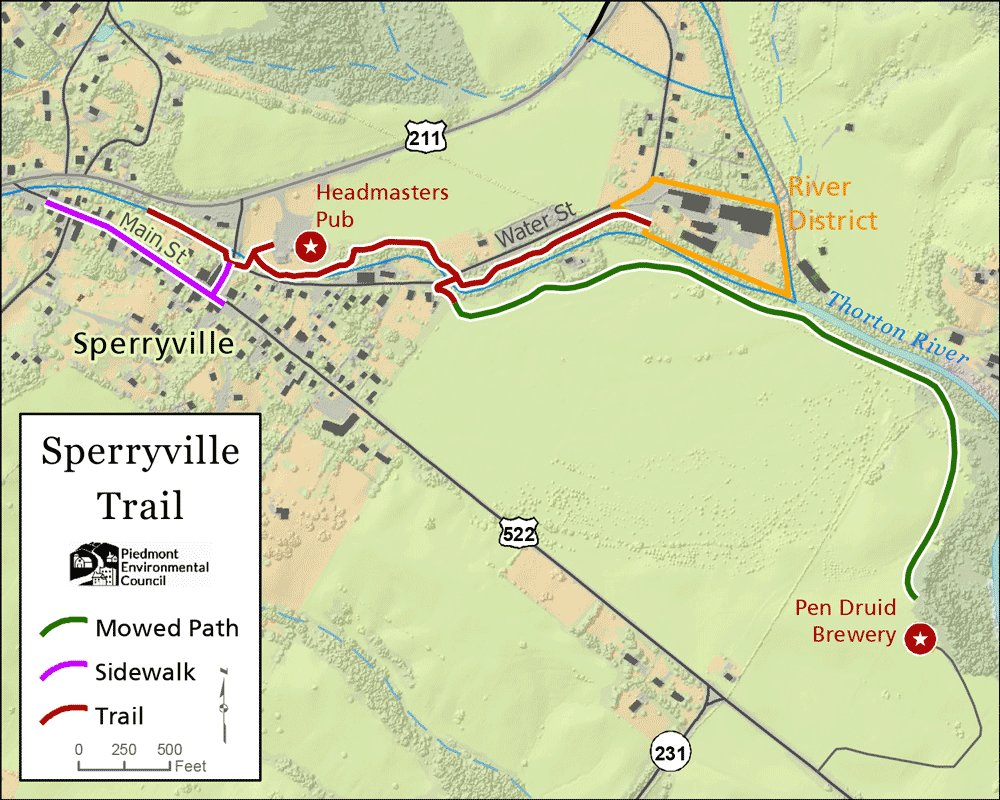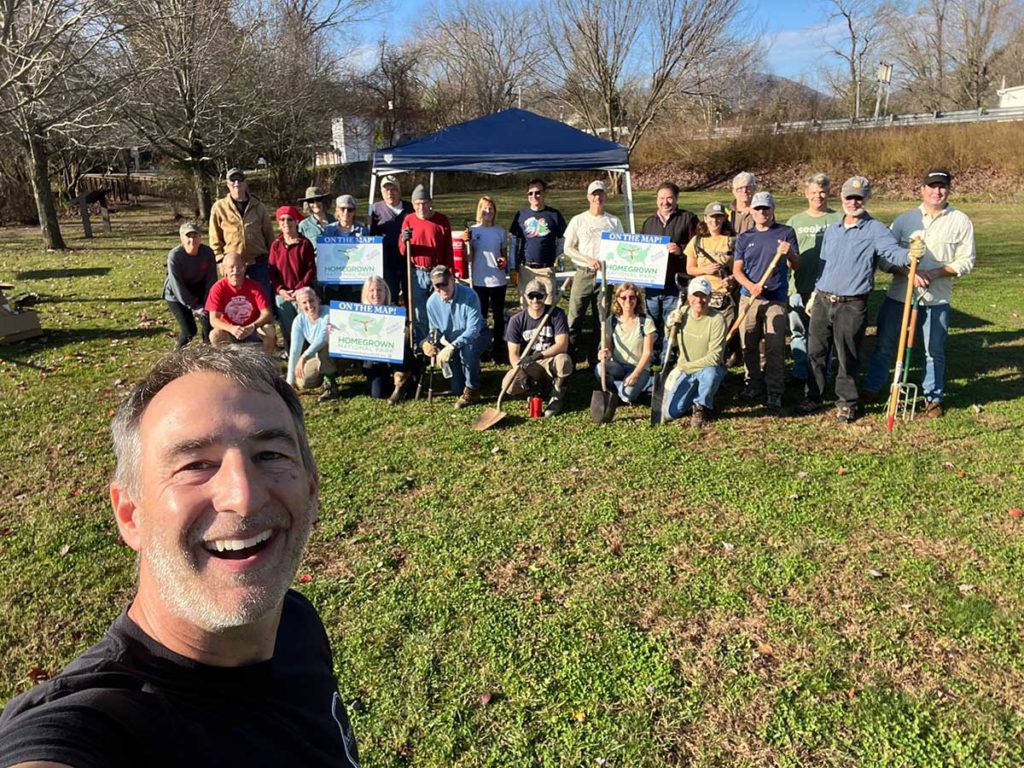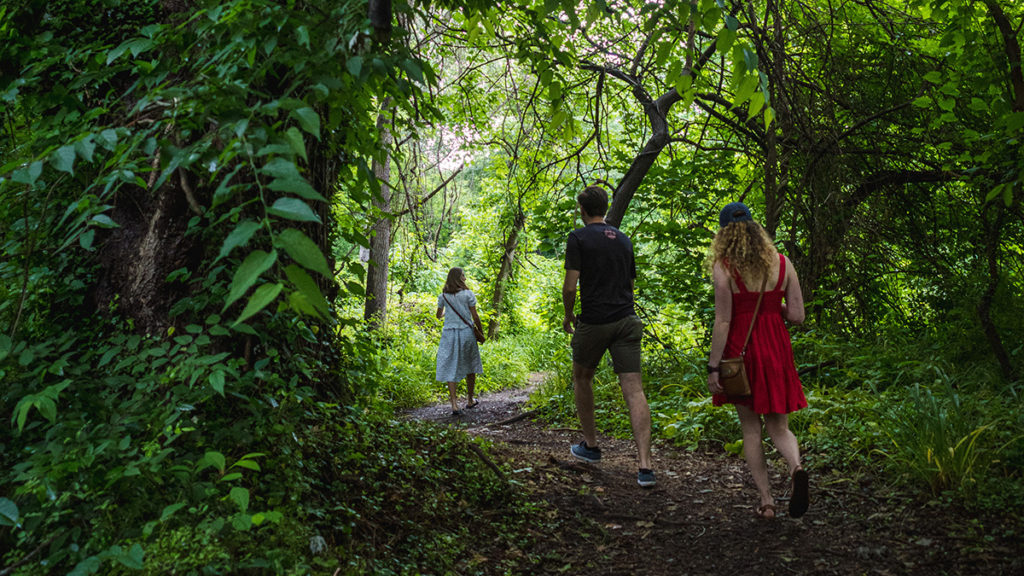
In my first year as the Rappahannock County Field Representative for The Piedmont Environmental Council, one central theme has jumped out: the importance of a sense of place in strengthening the connections between communities and the local natural environment. This sense of place is often what drives private landowners to conserve their land, and it’s one of the many reasons why expanding public access to the outdoors in the outdoors in the Piedmont is so critical. So, when I took on my current role with PEC, walking through the villages of Rappahannock to gain insight on the sense of place unique to each one was early on my to-do list.
In Sperryville, I was able to safely discover this village’s ecological, scenic, historic, economic, and agricultural features all on foot, just by traversing the roughly 1.5-mile Sperryville Trail Network. This spectacular community gem got its start in 2019 thanks to the Sperryville Community Alliance (the Alliance), an all-volunteer nonprofit made up of village residents and business owners who promote activities to enhance the safety, inclusiveness, and vitality of the Sperryville community.
A Walk Through Sperryville
You may have driven through Sperryville on your way to the Thornton Gap entrance to Shenandoah National Park. But this historic village is much more than just a place to pass through, and I found the Sperryville Trail Network to be the perfect tour guide.
I started my walk at its northernmost end on Main Street in Sperryville. The first 550 feet of the crushed stone and wood chip trail funnels pedestrians along the Thornton River, behind numerous local businesses that kindly share access through their lands with trail-goers, to the old Sperryville schoolhouse.
Further downstream, past other local businesses and across Route 522, the trail intersects Water Street and diverges into two paths. The left offers a safe connection to the village’s River District, while the right provides a direct walk all the way to Pen Druid, a local brewery previously only accessible by vehicle off of Route 522.
The latter option traverses Mount Vernon Farm, a beautiful property protected by a conservation easement held by the Virginia Outdoors Foundation. In fact, one of the things that makes the Sperryville Trail Network so special is that it’s a publicly accessible trail entirely on private land. “Simply stated, the network of trails would not be possible without the support and generosity of the landowners who have allowed the trail to cross their properties. They’ve been important to connecting our community and providing a safe and beautiful amenity for our residents and visitors, while drawing attention to the preservation and protection of the Thornton River,” said Kerry Sutten, president of the Alliance.
Joining the Effort
Once just a short trail in town, this pedestrian footpath has grown over the years into a true network of trails, both in its aggregate length and in its contribution to the fabric of the village. Here at PEC, we place strong value on public access to nature, knowing that it is critical to the health and well-being of people and communities. We also believe that when people experience nature, that exposure can help foster a deeper appreciation for the earth and build a mindset for conservation.

So when the Alliance approached PEC in late summer 2021, hoping to build upon the trail’s considerable success to date, our Krebser Fund provided funding to support the Alliance’s vision for enhancing, expanding and formalizing the Thornton River Trail portion of the trail network. Augmenting more than $52,000 the Sperryville Community Alliance raised locally, this support funded development of a trail management plan to guide trail improvements and community engagement opportunities.
I joined the PEC staff a few months later, and my subsequent collaboration with the Alliance and a newly formed Sperryville Trail Advisory Committee (STAC) was a crash course in the ripple effects of community-driven conservation efforts. The excitement was palpable at every STAC meeting, and after each one my mind swirled with lessons learned and new ideas about how the work we do on the ground matters most. When the Sperryville Trail Network Study and Invasive Species Management Plan was completed in November 2022, one thing was abundantly clear: the Thornton River’s riparian area is our next priority.
Restoring Native Tree Canopy
To the untrained eye, the Sperryville Trail Network is a stress-free jaunt through a natural haven of plants and wildlife. The parallel river, lovingly nicknamed the Mighty Thornton, is not only beautiful, but it is also classified as a Class II Wild Trout Stream a mere few miles upstream. Its banks are packed with vegetation essential for filtering nutrients and pesticides, stabilizing streambanks and providing wildlife habitat. But…
Once you learn to recognize non-native invasive species that threaten native trees and the overall health of the buffers, you suddenly realize this riparian corridor is being overtaken. An inventory for the Invasive Species Management Plan found that almost 70% of all the vegetation along the Thornton River consisted of over 40 different non-native invasive plant species, including English ivy (Hedera helix), tree of heaven (Ailanthus altissima), and multiflora rose (Rosa multiflora), which all appear on the state’s list of priority invasive species.
“The popularity of the Sperryville network of trails is increasing by the year,” said Clare Lindsay, who chairs the trail advisory committee and serves as vice president of the Rappahannock League of Environmental Protection’s board of directors. “It’s not only a favorite with locals, but also a lovely way for visitors to get a sense of our town and the beautiful landscape and waters that define it. We also hope that our trail stewardship will serve as an ongoing demonstration to residents and visitors of the importance of removing invasive species and re-establishing native species for the health of our local ecosystems,” Lindsay said.
It Takes a Village
As Sperryville and the participating private landowners have so clearly shown, it takes a village to build a trail. Beginning with a grant from the Virginia Department of Forestry, the Alliance and the trail advisory committee are now working with volunteers and other partners to restore the Thornton River’s riparian area. Last November, I joined over 20 volunteers for a trail work day to remove non-native invasive species, pick up trash, and plant trees donated by Friends of the Rappahannock. It was the kind of work that feels great — there’s something so satisfying about visible progress — but we’re certainly not done yet. There’ll be other work days as the weather warms, and looking ahead to this fall, once the invasive plants are removed, PEC is planning a volunteer tree planting in collaboration with the many stakeholders involved with the Sperryville Trail Network.
“The Alliance served as a catalyst for the creation of the trails that make up the Sperryville Trail Network and provides for their enhancement, expansion, and maintenance. But none of these activities would be possible without the efforts of our partner organizations and the hundreds of volunteers who have helped clear invasives, replant natives, move mulch, install signs, oversee contractors, and contribute over $100,000 in financial support,” Sutten said.

The interwoven benefits of the Sperryville Trail Network, and the community energy surrounding it, always bring me back to that sense of place that drives so much conservation work. The generosity of the landowners, the passion of the all volunteer Sperryville Community Alliance and its trail advisory committee, and the collaboration of many partner organizations all boil down to a commitment to protect and restore the places that we love — even, or maybe especially, with the recognition that there’s a long trail, I mean road, ahead.
This letter appeared in 2023 spring edition of The Piedmont Environmental Council’s member newsletter, The Piedmont View. If you’d like to become a PEC member or renew your membership, please visit pecva.org/join.
